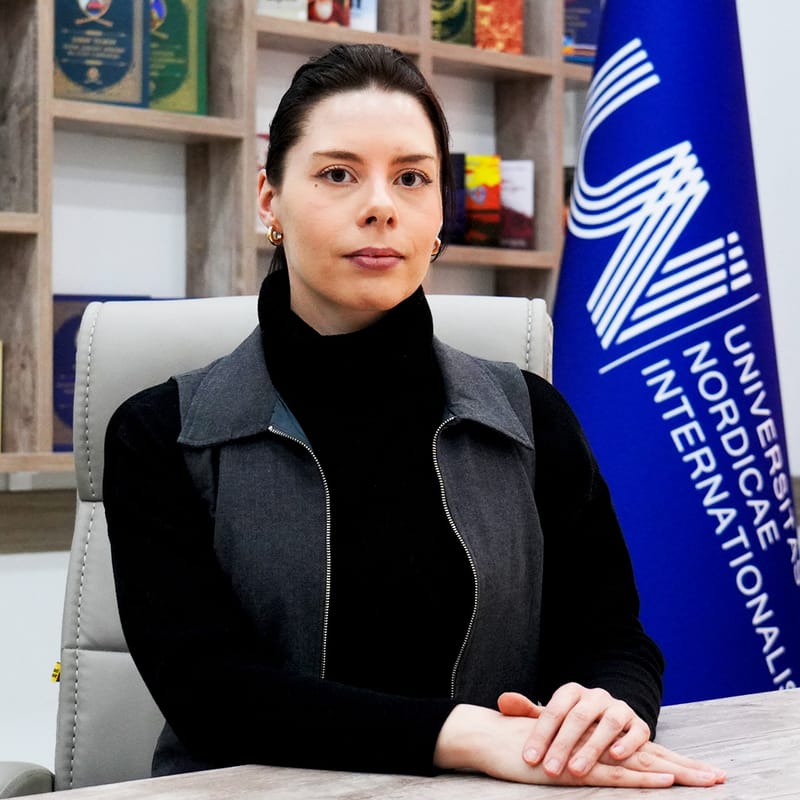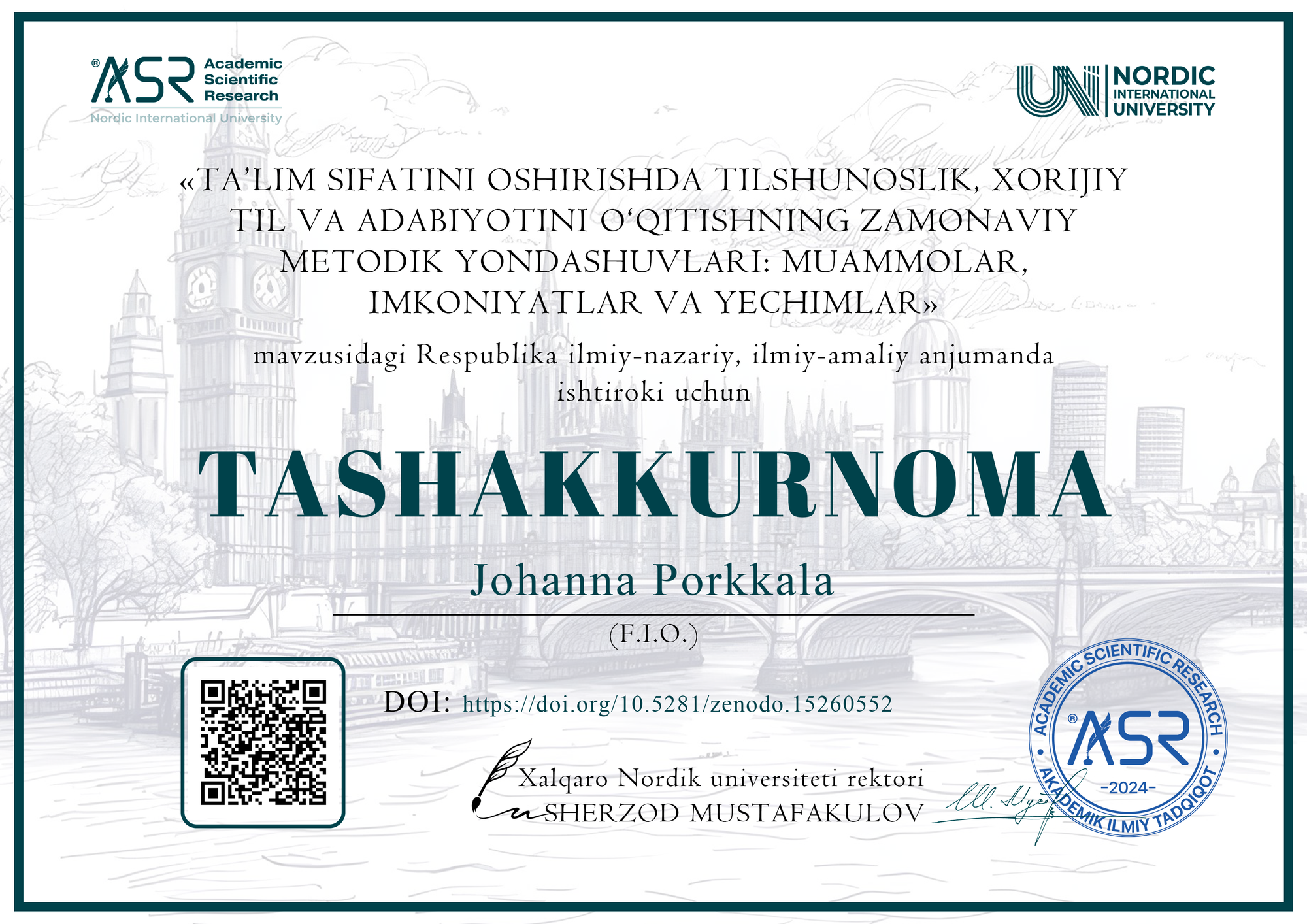
Johanna Porkkala
Nordic International University

DOI: https://doi.org/10.5281/zenodo.15260552
Nordic_press journal: https://research.nordicuniversity.org/index.php/nordic/article/view/2374
TASHAKKURNOMA
EFFECTIVE LANGUAGE TEACHING METHODS FROM THE LEARNER’S PERSPECTIVE
Johanna Porkkala
Nordic International University
Teaching a foreign language is no easy task, especially for more mature learners like university students. Teaching more mature learners also has its own challenges and peculiarities that have been studied through the perspective of the learner[1], in this paper we suggest that the perspective of a university level language learner can blend into the perspective of the educator, when the learner himself later becomes the teacher of the learned subject. In the larger picture this means that the roles of the educator and learner are not binary, but can rather shift and blend into each other - and work as a useful ground in navigating effective teaching methodologies in practice. As an adult learner and foreign language teacher who has successfully learned more than three foreign languages, the writer of this paper hopes to add to the conversation of choosing effective methodology for foreign language teaching, especially on university level.
This paper consists of two main notions on choosing methodology of teaching a foreign language as both a former learner and current teacher: 1. How the blended roles of educator/learner affects the navigation and choosing of the methodology of teaching a foreign language effectively. 2.: How this perspective helps recognize learning patterns in students. In this paper I also prefer to cite the term adult learning in the context of university level foreign language learning, as some studies show that language proficiency, especially in the EU-area, is shown to improve noticeably in higher education levels due to language courses (Eurostat, 2024)[2], giving us more reason to look at the methodology of language teaching on a higher level. Also the term adult learner helps us effectively exclude lower levels of education out of this conversation, while also giving us some theoretical background in explaining language teaching processes on this level.
Theory and practice - learning as navigation in choosing effective language teaching methodologies. Teaching mature learners gives us an interesting background in reflecting the processes of language teaching methodologies. According to Brookfield (2010)[3], every educator is a theorist. This means that every teacher applies their own ideas (theory) into practice, whether big or small - making it into a theory of education. As an example this could mean that the teacher makes the students watch videos in class to make it more interesting for them. This idea naturally makes every working teacher a theorist on effective teaching methodology and learners the subject of the theory applied. This theory of teaching (foreign languages in our case) can stem from the instinct and culture of the educator that they acquired while learning, according to Brookfield. In teaching foreign languages this instinct and personal experience can play a vital role in creating a working education theory for class. For example, in many cases the teachers of a foreign language are not native speakers, but rather also learners of the language(s) themselves, which, from the perspective of this conversation, affects the process of developing theory and practice in language education.
When it comes to choosing the most effective language learning practices in class, there exists already a wide range of language teaching methodologies, each very different from each other. To give a few examples, there are methods such as Grammar-Translation (GTM) which represents the more old-fashioned, vocabulary-focused teaching method. Audiolingualism was on the other hand created to combat the deficiencies of GTM and Community Language Learning (CLL) is an example of a shift towards learning not only individually, but rather socially[4]. It is certainly no easy task for teachers and students to navigate through these very different approaches successfully in practice, as all teachers and learners work differently. However, here the theorizing of the former-learner-turned-teacher comes into play. If the educator has gone through the process of learning one or more foreign languages somewhat successfully, it is highly suggestable that their own experiences could affect their choices in theorizing and practicing language teaching. This could, of course, lead into two results: one being that the teacher reuses more old-fashioned methods in their teaching, not engaging with contemporary teaching methods and technology of his time out of habit. The other outcome being, as a possible conversation starter, that the teacher has a deeper understanding of their own complex learning abilities and applies this experience successfully in teaching others, all while being able to engage with contemporary teaching technologies.
Experience as a learner helps to recognize patterns in students
Conclusions
In this paper, it was highlighted how the perspective of a former foreign language learner turned into a language teacher is useful in choosing an effective, holistic language teaching method at the adult education level. The key factor in not choosing only one effective method but rather combining many stems from the teacher’s past experiences as a language learner. In this paper, this phenomenon was explained through Brookfield’s (2010) suggestion that every teacher becomes a theorist in teaching, which can be driven by instinct and intuition. In our case, these two are shaped by past learning experiences of the teacher, which can turn out to be highly useful in practice, especially when choosing effective language teaching methods out of many in everyday practice. Even though there exists the mentioned danger that these past learning experiences affect the choice of teaching methods, this paper chooses to highlight the useful possibilities and insights it gives in the foreign language teaching process.
[1] Merriam, Sharan B., and Laura L. Bierema: 2013. Adult Learning : Linking Theory and Practice.
[2] Eurostat: Foreign language skills statistics. September 2024.:https://ec.europa.eu/eurostat/statistics-explained/index.php?title=Foreign_language_skills_statistics. (Searched:16.4.2025).
[3] Brookfield, S. D.: 2010. (pp. 71– 81).
[4] Sanako.com. The Best Language Teaching Strategies Explained.8.10.2021.:https://sanako.com/the-10-best-language-teaching-strategies-explained (Searched: 15.4.2025).



